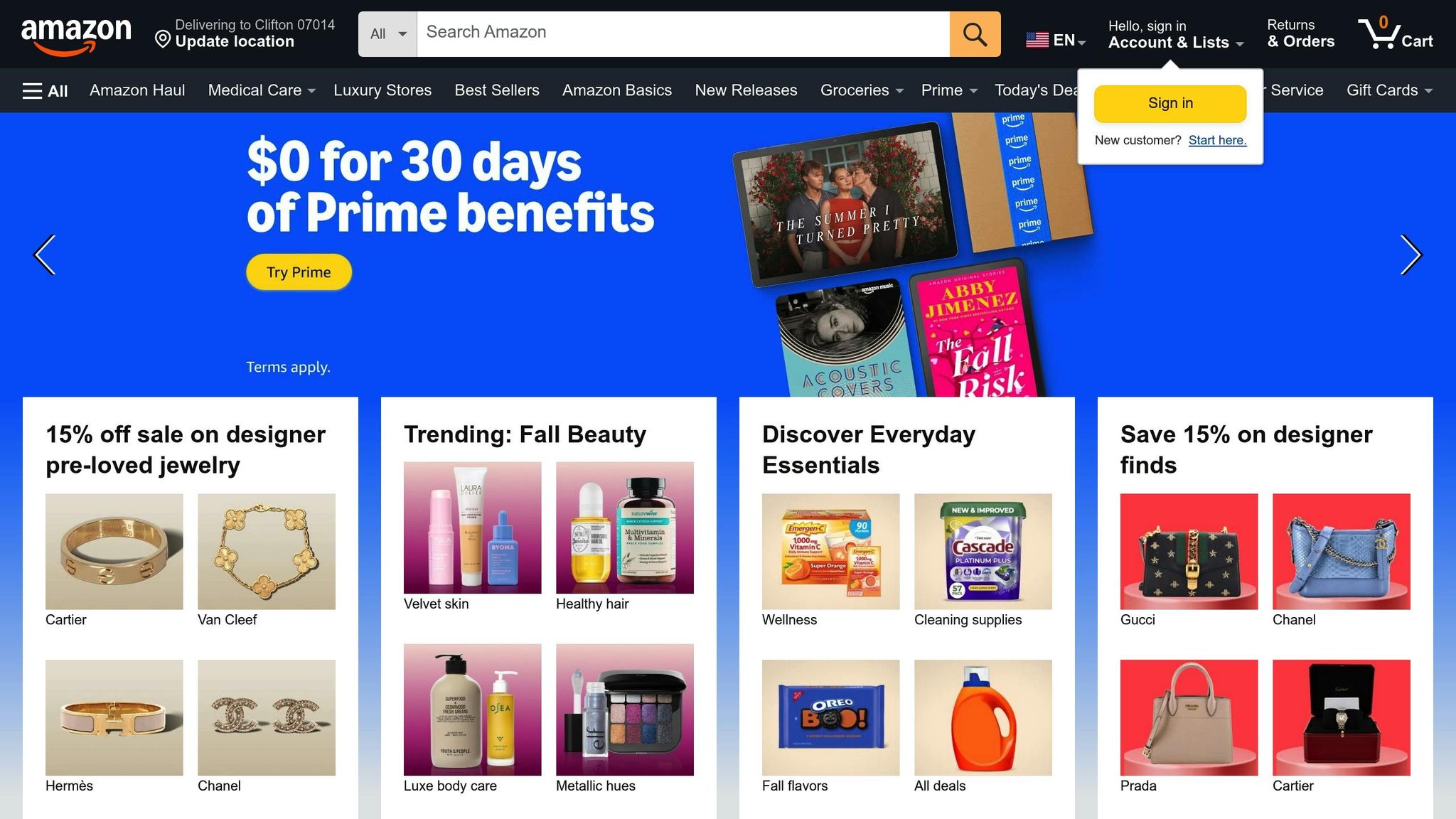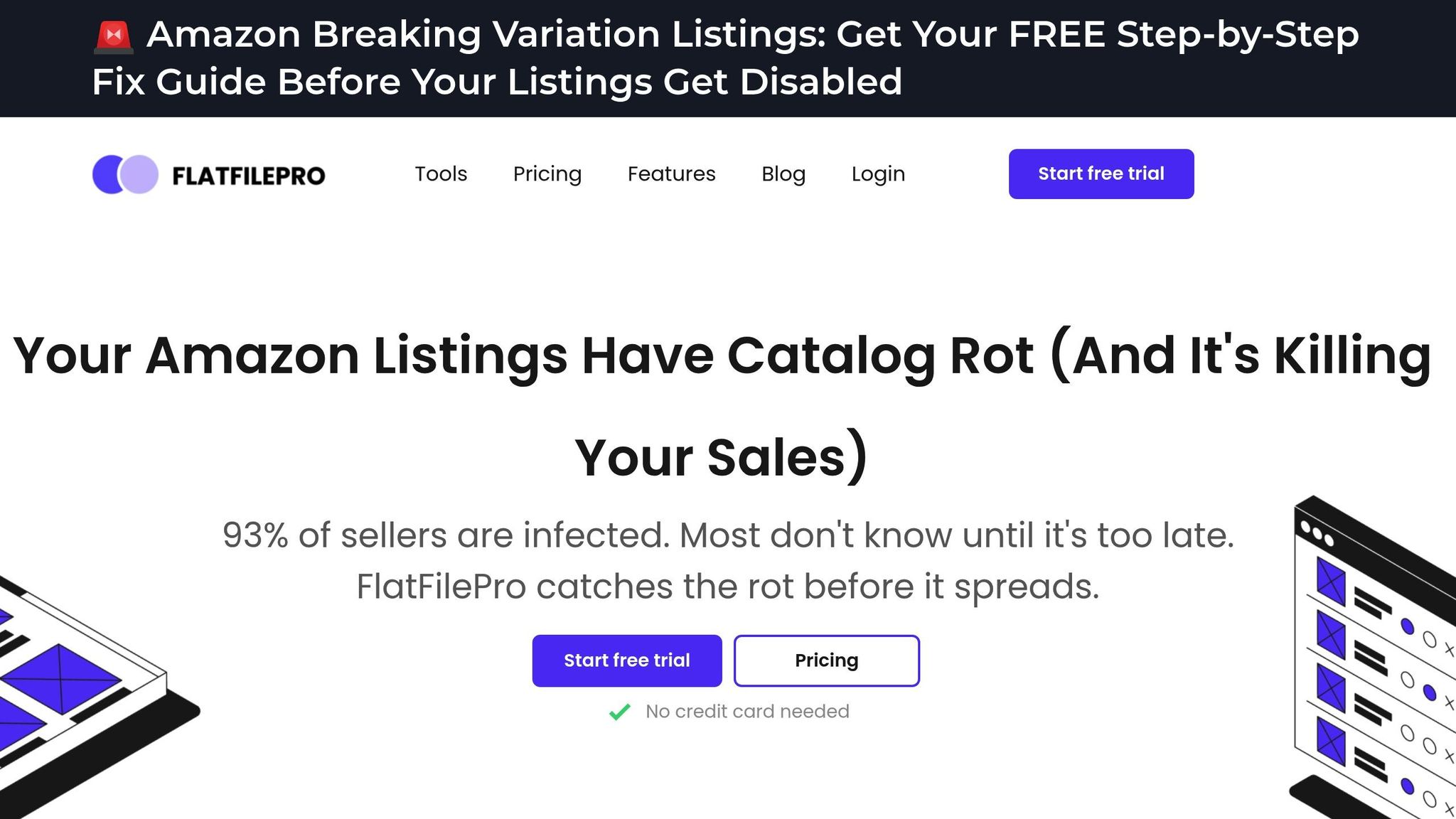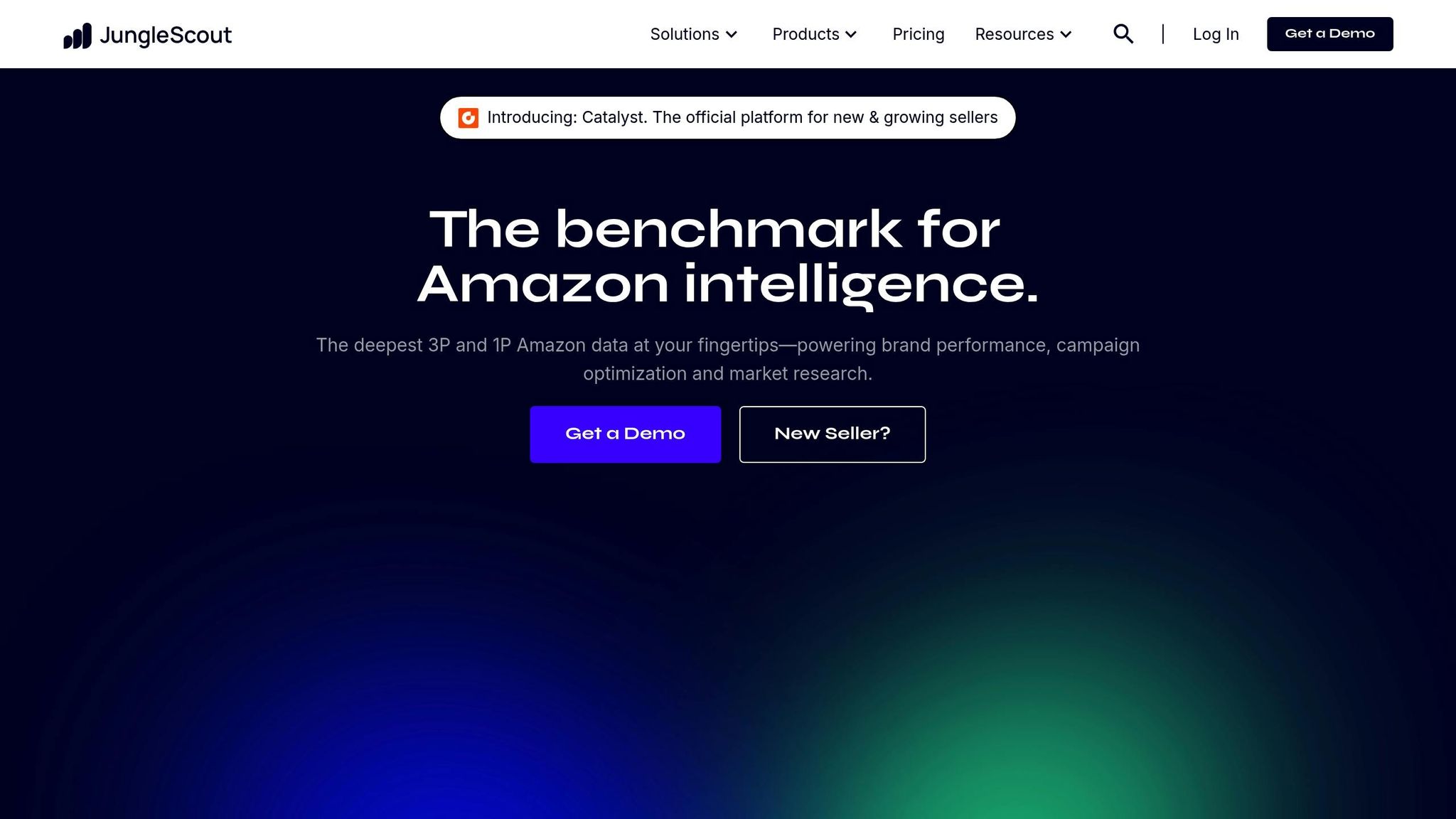Amazon sellers in 2025 face an increasingly competitive marketplace with over 1.7 million active sellers and 2.7 billion monthly site visits. Optimizing product listings is no longer optional – it’s a necessity for visibility and sales. Manual updates are time-consuming and error-prone, making software tools essential for sellers.
This article compares three leading Amazon listing optimization tools – FlatFilePro, Helium 10, and Jungle Scout – each tailored to specific seller needs:
- FlatFilePro: Best for bulk catalog management, offering unlimited SKU updates, nightly scans for errors, and efficient variation management. Pricing starts at $99/month.
- Helium 10: A versatile tool with bulk editing, keyword research, and analytics, ideal for sellers seeking an all-in-one solution. Pricing varies by plan.
- Jungle Scout: Focuses on individual listing optimization with keyword suggestions, optimization scores, and review automation. Designed for smaller catalogs.
Quick Comparison
| Feature | FlatFilePro | Helium 10 | Jungle Scout |
|---|---|---|---|
| Bulk Editing | Unlimited SKUs | Available on some plans | Primarily for individual listings |
| Real-time Monitoring | Nightly scans | Basic tracking | Optimization scores |
| Variation Management | Drag-and-drop interface | Traditional flat files | Individual focus |
| Starting Price | $99/month | Varies | Varies |
| Best For | Large catalogs | All-in-one strategies | Smaller catalogs |
Each tool addresses unique challenges, from bulk updates to detailed listing refinements. Choose based on your catalog size, budget, and management needs.
I tested every Amazon listing optimization tool. These are the best
1. FlatFilePro
FlatFilePro is a purpose-built Amazon listing management tool created by seasoned Amazon sellers who know the ins and outs of catalog management. By leveraging direct API integration, it eliminates the need for time-consuming spreadsheet uploads.
Core Features and Capabilities
FlatFilePro’s standout feature is its Reflection Engine, which scans listings nightly. Accurate data gets a green checkmark, while discrepancies are flagged with a red X, making it easy to spot and fix issues.
With bulk editing, you can update an unlimited number of SKUs in minutes. Tasks that might take over 40 hours in Seller Central can be done in under 5 minutes here.
The drag-and-drop Variations Manager simplifies moving child products between parent ASINs. In just three clicks, you can manage variations with a success rate of 95%, far exceeding traditional methods.
FlatFilePro also integrates seamlessly with Amazon’s systems, ensuring real-time monitoring and updates across your catalog.
Integration and Performance Monitoring
The platform synchronizes listing data multiple times a day, offering real-time status updates for all submissions. It also has an automated system that scans listings for missing fields, compliance issues, and SEO improvements. Errors are categorized into groups like Product Identity, Details, Shipping, and Safety, helping you focus on fixes that will have the biggest impact on your sales.
From a single dashboard, FlatFilePro lets you synchronize listings across major marketplaces, including the US, UK, Canada, and Germany. This makes content replication and competitor tracking straightforward and efficient.
Pricing Structure and Plans
FlatFilePro operates on a straightforward, usage-based pricing model. You can try all its features with a 30-day free trial before committing.
| Plan | Monthly Price | Best For | Key Features |
|---|---|---|---|
| Standard | $99 | Brand owners, in-house marketers | Unlimited ASINs, bulk edits, Reflection Engine, Variations Manager |
| Enterprise | $499 | Large brands, agencies, aggregators | All Standard features plus a custom PostgreSQL database with BI views |
The Standard plan includes two marketplace connectors, with additional connectors available for $29 each per month.
Expert Assessment and User Feedback
FlatFilePro has earned a 9.2/10 rating from industry experts, who praise its ease of setup and efficient catalog management. Users highlight how quickly mass updates can be made, though some mention that the $99 monthly fee might be a hurdle for smaller sellers. Additionally, certain advanced features come with a learning curve [2].
2. Helium 10
Helium 10 simplifies managing large product catalogs by allowing bulk updates across multiple listings at once. This feature not only saves time but also minimizes the risk of manual errors, ensuring your listings remain consistent and accurate. For sellers with extensive inventories, it’s a game-changer, streamlining what could otherwise be a tedious process. By focusing on efficient bulk editing, Helium 10 stands out as a practical tool for maintaining catalog precision while complementing the unique features offered by other optimization tools.
sbb-itb-ed4fa17
3. Jungle Scout
Unlike bulk editing tools, Jungle Scout zeroes in on optimizing individual product listings to improve visibility and performance.
At the heart of this approach is the Listing Builder tool, which helps sellers refine their listings. The tool suggests relevant keywords and provides an optimization score – a metric that evaluates how well your listing aligns with Amazon’s ranking factors. This feedback enables sellers to make precise, data-backed adjustments.
With Jungle Scout, you can import listings directly from Seller Central, optimize them, and sync the updates back to Amazon with a single click [1]. This seamless integration eliminates the hassle of manual data transfers, saving valuable time.
The platform also analyzes your product data to recommend keywords and offers real-time optimization scores, making it easier to fine-tune listings for better results. While it doesn’t feature traditional bulk editing, Jungle Scout includes Review Automation through a browser extension. This feature allows sellers to send multiple review requests at once, simplifying the process of gathering social proof.
For sellers who prefer focusing on one product at a time, Jungle Scout’s individual optimization strategy is a perfect fit. This method ensures each product gets the attention it deserves, rather than applying broad changes across the entire catalog.
Pros and Cons
Taking a closer look at the strengths and weaknesses of each tool helps highlight how they cater to different seller needs on Amazon.
FlatFilePro is a standout for bulk catalog management, offering automated nightly monitoring to catch discrepancies and enabling unlimited SKU updates in just minutes. However, its $99 monthly price for the standard plan can be a steep cost for smaller sellers. Another limitation is its focus on catalog management, leaving out features like keyword research and market analysis.
Helium 10 provides a wide range of tools, but its extensive features can feel overwhelming for some users. Sellers looking for advanced bulk editing may also need to opt for higher-tier plans, which could increase costs.
Jungle Scout shines in optimizing individual listings with a simple import-optimize-sync workflow. This makes it ideal for managing smaller catalogs, but it lacks the robust bulk editing capabilities that larger inventory sellers might require.
Here’s a quick comparison of their features:
| Feature | FlatFilePro | Helium 10 | Jungle Scout |
|---|---|---|---|
| Bulk Editing | Unlimited SKUs with one-click updates | Available on select plans | Primarily for individual listings |
| Real-time Monitoring | Nightly scans via Reflection Engine | Basic listing tracking | Displays optimization scores |
| Variation Management | Drag-and-drop interface, 95% success rate | Traditional flat file approach | Focused on individual variations |
| Starting Price | $99/month | Varies | Varies |
| Ideal For | Large catalogs and bulk operations | All-in-one strategies | Individual product optimization |
Integration options also set these tools apart. FlatFilePro offers a direct API connection, eliminating the hassle of flat file uploads. Jungle Scout integrates seamlessly with Seller Central, while Helium 10 connects broadly across Amazon’s ecosystem, though its setup process may take a bit longer.
For sellers who prioritize catalog protection, FlatFilePro’s automated monitoring is a key feature, ensuring all content slots are filled to safeguard listings. On the other hand, sellers focused on in-depth market research may prefer Helium 10’s extensive tools or Jungle Scout’s targeted optimization features.
Ultimately, these insights help sellers select the tool that best aligns with their needs, whether it’s streamlining catalog management or boosting overall performance on Amazon.
Conclusion
Choosing the right tool depends on your catalog size, budget, and management requirements. Each platform brings distinct strengths to tackle the catalog challenges we’ve discussed.
FlatFilePro stands out for bulk updates, offering unlimited SKU updates, nightly listing scans, and an impressive 95% success rate for variation updates – all under a single-tier pricing model. This makes it a solid option for enterprise sellers, agencies, or brands needing reliable catalog health and seamless team collaboration [3].
Helium 10 offers a comprehensive suite of tools, from product research to advertising optimization, with higher usage limits. Its versatility makes it an ideal choice for growing businesses that need both market insights and listing management in one platform [4].
Jungle Scout focuses on precision for individual listing optimizations, making it a great fit for sellers with smaller catalogs who prioritize detailed, one-by-one adjustments.
When making your decision, consider your specific challenges and budget. FlatFilePro’s predictable pricing is perfect for bulk catalog management, Helium 10’s tiered structure supports scalability, and Jungle Scout caters to sellers needing fine-tuned optimizations.
Take advantage of free trials to see which platform aligns best with your needs. With the right tool, you can simplify catalog management and improve product performance on Amazon.
FAQs
What features make FlatFilePro ideal for managing large Amazon catalogs?
FlatFilePro tackles the challenge of managing large Amazon catalogs effortlessly, thanks to its API-based framework. This setup streamlines bulk editing and ensures real-time validation, reducing errors and simplifying the task of updating extensive product listings.
Here’s what makes FlatFilePro stand out:
- Bulk editing capabilities: Update hundreds or even thousands of listings in just a few minutes.
- Automatic error detection: Validates fields before uploads, helping you avoid costly mistakes.
- Parent-child relationship management: Perfect for organizing and maintaining complex product variations.
On top of that, FlatFilePro offers performance tracking tools to measure the impact of your edits. This ensures your catalog stays optimized for better visibility and higher conversions.
How does FlatFilePro’s Reflection Engine make managing Amazon listings faster and more accurate?
FlatFilePro’s Reflection Engine takes the hassle out of managing Amazon listings by automating error detection and offering real-time monitoring. This means fewer manual tasks and reduced listing errors, allowing sellers to keep their product catalogs accurate and well-organized.
With features like quick bulk uploads and edits, the platform makes updates up to 17 times faster than using traditional spreadsheets. It also offers tools like version reversion for seasonal adjustments, secure offsite storage, automated backups, and user permission settings to block unauthorized changes. These capabilities work together to simplify catalog management and improve efficiency for Amazon sellers.
How do I decide between the Standard and Enterprise plans of FlatFilePro?
When choosing between the Standard and Enterprise plans of FlatFilePro, it’s important to weigh factors like your business size, growth ambitions, and budget. The Standard plan works well for smaller businesses that need core tools to manage their product catalog. On the other hand, the Enterprise plan is designed for larger companies or those experiencing rapid growth, offering advanced features, more customization options, and enhanced support.
Consider how complex your product catalog is, the level of integration your systems require, and whether your operations could benefit from added flexibility and support. Taking these aspects into account will help you select the plan that aligns best with your business needs.




